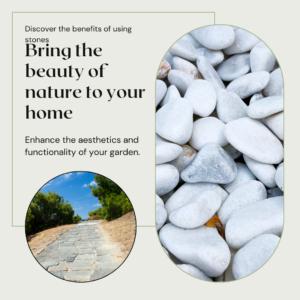
If you’re looking to transform your outdoor space, incorporating decorative stones into your landscape design can provide a multitude of benefits. From enhancing the visual appeal of your garden to functional uses such as erosion prevention, stone elements can elevate your landscape design to a whole new level.
With a variety of options to choose from, including natural and manufactured materials, stone features can add character and charm to any garden. Whether you’re looking to create a sleek and modern design or a rustic and natural feel, stones can help you achieve your desired aesthetic.
Key Takeaways:
- Decorative stones can improve the overall appearance of your outdoor space.
- Stone elements can have practical uses such as erosion prevention or creating defined spaces.
- Natural and manufactured options are available to achieve various aesthetics.
- Stones offer durability and can withstand the test of time when properly maintained.
- Stone walkways and pathways can provide functionality while enhancing aesthetics.
Factors to Consider When Choosing Stones for Your Landscape
Choosing the right stones for your landscape design involves careful consideration of several factors. These elements will guide you toward the right decorative stones, helping you create an outdoor space that is both functional and aesthetically pleasing.
Durability
Durability is a critical factor to consider. The stones you choose must withstand the harsh outdoor climate and elements. Some stones are more porous than others, making them more susceptible to staining, cracking, and erosion. Natural stones like granite, limestone, and sandstone are typically more durable than manufactured or concrete options.
Color Scheme
The color scheme of your landscape design can enhance or detract from the overall aesthetic. Choose stones that complement the current color scheme of your home, or select a stone that creates a beautiful contrast. It’s essential to consider how the stone’s color will appear under different lighting conditions, such as full sunlight or shade.
Size
The size of your stones will determine the level of texture and visual interest within your landscape. Large rocks can add focal points, while smaller stones create a uniform look. Additionally, the size of your stones must fit the scale of your landscape, ensuring they don’t look too small or too big.
Texture
Texture adds depth and dimension to your landscape design. Stones with natural textures like slate or flagstone can create a rustic look, while polished stones like granite have a contemporary feel. Consider how the texture of your stones will impact the overall look and feel of your landscape.
By keeping these factors in mind, you can make informed decisions about your stone choices and ensure that they align with your overall landscape design.
Natural Stone Options for Landscaping
If you’re looking for a durable and aesthetic option for your landscape, natural stones should definitely be on your list. These stones are mined from quarries and are available in a wide variety of colors, sizes, and textures to complement your overall landscaping design. They are resistant to weather and UV light and can handle heavy foot traffic, making them perfect for garden walkways and patios. Here are some popular choices for natural stones:
| Stone Type | Advantages |
|---|---|
| Granite | Durable, low maintenance, available in various colors and textures. |
| Limestone | Soft and elegant appearance, great for pool decks and patios. |
| Slate | Non-slip surface, perfect for walkways and stairs, available in various colors. |
| Travertine | Stylish and classic look, ideal for pool decks and patios, durable and easy to maintain. |
Each natural stone option provides its own unique benefits. Granite is known for its durability and variety, while limestone offers a luxurious and soft appearance. Slate is perfect for walkways and stairs due to its non-slip surface, and travertine provides a classic, stylish look for pool decks and patios.
By incorporating natural stones into your landscape design, you can create an elegant and sophisticated outdoor space that will last for years to come.
Concrete Pavers and Bricks in Landscape Design
When it comes to adding personality and functionality to your outdoor space, concrete pavers and bricks are two popular choices. Their versatility makes them perfect for various landscape designs, whether you’re planning on creating a contemporary garden or a traditional backyard.
One of the significant benefits of using concrete pavers and bricks is their durability. They can withstand high traffic areas, harsh weather conditions, and are resistant to staining and fading.
Moreover, these materials are incredibly easy to install, making them ideal for those who want to take a DIY approach to their landscaping. You need minimal equipment and expertise to lay them down, and the process usually takes only a couple of days.
Designs and Patterns
Concrete pavers and bricks offer a wide range of designs and patterns, allowing you to customize your outdoor space to your liking.
| Designs and Patterns | Advantages |
|---|---|
| Herringbone | Durable and stable, suitable for high traffic areas |
| Running bond | Visually appealing, creates an illusion of space |
| Circular | A classic look, perfect for patios and walkways |
The variety of choices can fit any landscaping style and aesthetic preference, from rustic to modern.
Using concrete pavers and bricks in your landscape design is not only practical but also aesthetically pleasing.
They offer a budget-friendly solution that can transform your yard or garden into an inviting and functional space. Whether you’re planning on creating a spacious patio or a winding pathway, choosing concrete pavers and bricks can help you achieve your landscaping goals.
Stone Retaining Walls and Edging in Landscape Design
Stone retaining walls and edging can be valuable additions to your landscape design. Not only can they add to your outdoor space’s visual appeal, but they also have practical uses. Retaining walls prevent soil erosion and create a defined area where different elements of your landscape can coexist. Stone edging, on the other hand, adds character to your garden while clearly showing the boundary between your landscaped area and other parts of your yard.
Incorporating stone retaining walls and edging into your landscape design has several advantages:
- Prevents Soil Erosion: Stone retaining walls ensure that your soil doesn’t wash away as water runs through your landscape during times of heavy rainfall. They help maintain the soil’s structure, providing a stable foundation for your plants to grow healthy and strong.
- Creates Defined Spaces: Retaining walls can help separate different areas of your landscape, such as a seating area, flower bed, or vegetable garden. Stone edging can divide the lawn from a flower bed or walking path, creating a visual boundary that adds style and symmetry to your garden.
- Adds Character: Stone retaining walls and edging add texture and depth to your garden. Since they come in a variety of sizes, shapes, and colors, they can be used to complement the existing elements of your landscape while carving out a unique design.
When planning to install stone retaining walls or edging in your garden, ensure you consider factors such as height, drainage, and materials. Professional landscape designers can help you select suitable stones that fit your budget and meet your design needs.
Stone Walkways and Pathways in Landscape Design
If you’re looking to upgrade your landscape, a stone walkway or pathway can instantly elevate the overall style and functionality of your outdoor space. Using stones for walkways and pathways not only adds a natural and timeless touch to your garden but also offers several benefits that can enhance your yard’s appeal.
Benefits of using stone walkways and pathways
- Durability: Stone is known for its resilience, enduring different weather conditions and foot traffic, making it an ideal material for high traffic areas such as walkways and pathways.
- Versatility: Stone comes in various shapes, colors, and textures, providing endless design options for creating unique and appealing walkways or pathways.
- Safety: Walking on a slippery surface can be hazardous, particularly in areas with water features. Using stone pavers with a rough or textured surface can improve safety by reducing slips and falls.
Furthermore, incorporating stone walkways and pathways into your landscape design can add a cohesive and structured look to your garden. It helps guide visitors to the different areas of your yard, such as the patio, swimming pool, or seating areas.
| Stone Type | Benefits |
|---|---|
| Slate Stones | Stylish and slip-resistant, with natural color variations |
| Quartzite Pavers | Durable and eco-friendly, with stylish and timeless aesthetics |
| Travertine Tiles | Naturally slip-resistant and cool to the touch, ideal for hot weather areas. Comes in different colors and sizes to fit any design. |
Incorporating stone walkways and pathways into your landscape design can be a game-changer, providing both visual appeal and functionality. Whether you opt for natural stone or manufactured options, stone walkways and pathways offer lasting beauty with low maintenance.
Enhancing Aesthetics with Different Stone Materials and Styles
To truly elevate the visual appeal of your landscape design, it’s essential to incorporate a variety of stone materials and styles that complement each other. By combining different textures, colors, and shapes, you can create a cohesive and visually appealing outdoor space.
One popular material is natural stone, which comes in a range of styles such as limestone, granite, and slate. Natural stones offer unique textures and colors that enhance the beauty of any landscape design. Consider the warm, earthy tones of sandstone or the vibrant hues of flagstone to create a natural, organic look for your garden.
If you’re looking for a more uniform aesthetic, manufactured options like concrete pavers and bricks can provide a consistent look and feel. Use these materials in combination with decorative stones to add depth and diversity to your outdoor space.
When selecting the various stone materials, you should also consider the different styles available. From irregular, natural-looking stones to smooth, polished surfaces, each style can create a distinct look for your landscape design.
“By combining different stone materials and styles, you can tailor your landscape design to your unique taste and lifestyle.”
Creating a Cohesive Design with Stone Materials
| Stone Material | Texture | Color | Shape |
|---|---|---|---|
| Limestone | Rough | Beige | Natural |
| Sandstone | Smooth | Red, Orange, Yellow | Irregular |
| Concrete Pavers | Uniform | Gray | Rectangular |
| Flagstone | Rough | Multicolored | Irregular |
By choosing stone materials with complementary textures, colors, and shapes, you can create a cohesive landscape design that stands out. For example, use rough, irregular stones for natural pathways and smooth concrete pavers for patios and outdoor living areas. Adding colorful flagstones to garden beds can create striking contrast and visual interest.
Play around with different stone materials and styles to create a landscape that showcases your unique style and personality. By taking the time to carefully select and combine these elements, you can transform your outdoor space into a stunning and inviting oasis.
Combining Durability and Aesthetics in Your Landscape Design
When choosing stones for your landscape, it’s important to consider not just their aesthetic appeal, but also their durability. After all, your outdoor space should not only look beautiful but also withstand the test of time.
Fortunately, there are plenty of options that can offer both. Natural stones like granite, limestone, and slate are not only visually striking but also incredibly durable. Additionally, concrete pavers and bricks can provide a long-lasting solution that can also add charm and character to your landscape.
One way to combine durability and aesthetics is to select stones that are both functional and visually appealing. For example, you might consider using natural stone for a retaining wall or edging, both of which can provide practical benefits while adding visual interest to your landscape.
Another way to achieve this balance is by experimenting with different stone materials and styles. You can mix and match materials, like concrete pavers and natural stone, to create a textured and visually engaging look, or opt for different colors and sizes to add depth and interest.
Ultimately, the key is to choose stones and materials that not only elevate the overall aesthetic of your garden but also offer practical benefits. By combining durability and aesthetics, you can create a landscape that is not only beautiful but also built to last.
FAQ
Q. What are the benefits of using stones in landscape design?
A. Using stones in landscape design offers numerous benefits, including enhancing the visual appeal of your outdoor space, providing natural and sustainable elements, reducing soil erosion, and creating a low-maintenance environment.
Q. What factors should I consider when choosing stones for my landscape?
A. When selecting stones for your landscape, it’s important to consider factors such as durability, color scheme, size, texture, and overall aesthetic compatibility with your design vision.
Q. What are some natural stone options for landscaping?
A. There are various natural stone options for landscaping, including granite, limestone, slate, and travertine. These stones offer unique characteristics and benefits, such as durability, versatility, and timeless beauty.
Q. What are the benefits of using concrete pavers and bricks in landscape design?
A. Concrete pavers and bricks are popular options in landscape design due to their durability, easy installation, and the wide range of designs and patterns available. They can add charm, functionality, and versatility to your outdoor space.
Q. What are the advantages of incorporating stone retaining walls in my landscape?
A. Stone retaining walls not only add visual interest and character to your landscape but also help prevent soil erosion, create defined spaces, provide structural support, and offer potential seating options in your outdoor area.
Q. What types of stone edging options are available and what are their benefits?
A. Some common stone edging options are flat stone edging, cobblestone edging, and natural stone blocks. These options can provide a neat and defined edge to your landscape, prevent grass or mulch from spilling over, and add a touch of elegance to your design.
Q. What are the advantages of using stone walkways and pathways in landscape design?
A. Stone walkways and pathways offer durability, easy maintenance, visual appeal, and functionality. They can create a natural flow through your landscape, enhance the aesthetics, and provide a safe and inviting route for you and your guests.
Q. How can different stone materials and styles enhance the aesthetics of my landscape?
A. Incorporating different stone materials and styles allows you to play with textures, colors, and shapes in your landscape design. Natural stones like flagstone or bluestone can offer a rustic charm, while sleek and contemporary options like concrete or limestone can create a modern look.
Q. How can I combine durability and aesthetics in my landscape design?
A. To achieve the balance between durability and aesthetics, choose stones and materials that are not only visually appealing but also able to withstand the elements and regular use. Consider factors like resistance to weather conditions, foot traffic, and proper installation techniques.
Q. What maintenance tips should I follow for stone features in my outdoor space?
A. Regular maintenance for stone features in your landscape includes cleaning away debris, removing weeds or moss, inspecting for any damage or instability, sealing the stones when necessary, and addressing any drainage issues promptly. These simple steps will help keep your stone features looking their best and extend their lifespan.
Conclusion
Congratulations! You now understand the benefits of using decorative stones for landscaping and how they can transform your outdoor space. By considering factors like color, texture, and durability when selecting stones, you can create a design that enhances the overall aesthetics of your garden.
Whether you choose natural stones like granite and limestone or manufactured options like concrete pavers and bricks, incorporating these materials can add both functional and aesthetic appeal to your landscape.
Remember to maintain your stone features regularly to ensure they continue to beautify your outdoor area for years to come. With the right maintenance and care, your stone retaining walls, walkways, and edging can withstand the test of time and weather.
So, what are you waiting for? Start exploring different stone materials and styles to create a beautiful and inviting landscape design that you can enjoy for years to come.
















